Microstructure and Interfaces of Ultra-Thin Epitaxial AlN Films Grown by Plasma-Enhanced Atomic Layer Deposition at Relatively Low Temperatures
Abstract
1. Introduction
2. Experimental
2.1. Growth Parameters
2.2. Characterization Techniques: XRD and TEM
3. Results and Discussion
4. Summary and Conclusions
Author Contributions
Funding
Institutional Review Board Statement
Informed Consent Statement
Data Availability Statement
Acknowledgments
Conflicts of Interest
References
- Nepal, N.; Mahadik, N.A.; Nyakiti, L.O.; Qadri, S.B.; Mehl, M.J.; Hite, J.K.; Eddy, J.C.R. Epitaxial Growth of Cubic and Hexagonal InN Thin Films via Plasma-Assisted Atomic Layer Epitaxy. Cryst. Growth Des. 2013, 13, 1485–1490. [Google Scholar] [CrossRef]
- Nepal, N.; Qadri, S.B.; Hite, J.K.; Mahadik, N.A.; Mastro, M.A.; Eddy, C.R. Epitaxial growth of AlN films via plasma-assisted atomic layer epitaxy. Appl. Phys. Lett. 2013, 103, 082110. [Google Scholar] [CrossRef]
- Vurgaftman, I.; Meyer, J.R.; Ram-Mohan, L.R. Band parameters for III–V compound semiconductors and their alloys. J. Appl. Phys. 2001, 89, 5815–5875. [Google Scholar] [CrossRef]
- Ho, I.; Stringfellow, G.B. Solid phase immiscibility in GaInN. Appl. Phys. Lett. 1996, 69, 2701–2703. [Google Scholar] [CrossRef]
- Jain, S.C.; Willander, M.; Narayan, J.; Van Overstraeten, R. III–nitrides: Growth, characterization, and properties. J. Appl. Phys. 2000, 87, 965–1006. [Google Scholar] [CrossRef]
- Bardhan, A.; Mohan, N.; Chandrasekar, H.; Ghosh, P.; Rao, D.V.S.; Raghavan, S. The role of surface roughness on dislocation bending and stress evolution in low mobility AlGaN films during growth. J. Appl. Phys. 2018, 123, 165108. [Google Scholar] [CrossRef]
- Raghavan, S. Kinetic approach to dislocation bending in low-mobility films. Phys. Rev. B 2011, 83, 052102. [Google Scholar] [CrossRef]
- Hirayama, H.; Fujikawa, S.; Norimatsu, J.; Takano, T.; Tsubaki, K.; Kamata, N. Fabrication of a low threading dislocation density ELO-AlN template for application to deep-UV LEDs. Phys. Status Solidi C 2009, 6, S356–S359. [Google Scholar] [CrossRef]
- Chen, Z.; Fareed, R.S.Q.; Gaevski, M.; Adivarahan, V.; Yang, J.W.; Khan, A.; Mei, J.; Ponce, F.A. Pulsed lateral epitaxial overgrowth of aluminum nitride on sapphire substrates. Appl. Phys. Lett. 2006, 89, 081905. [Google Scholar] [CrossRef]
- Zeimer, U.; Kueller, V.; Knauer, A.; Mogilatenko, A.; Weyers, M.; Kneissl, M. High quality AlGaN grown on ELO AlN/sapphire templates. J. Cryst. Growth 2013, 377, 32–36. [Google Scholar] [CrossRef]
- Imura, M.; Nakano, K.; Narita, G.; Fujimoto, N.; Okada, N.; Balakrishnan, K.; Iwaya, M.; Kamiyama, S.; Amano, H.; Akasaki, I.; et al. Epitaxial lateral overgrowth of AlN on trench-patterned AlN layers. J. Cryst. Growth 2007, 298, 257–260. [Google Scholar] [CrossRef]
- Paduano, Q.; Weyburne, D. Optimized Coalescence Method for the Metalorganic Chemical Vapor Deposition (MOCVD) Growth of High Quality Al-Polarity AlN Films on Sapphire. Jpn. J. Appl. Phys. 2005, 44, L150–L152. [Google Scholar] [CrossRef]
- Sang, L.W.; Qin, Z.X.; Fang, H.; Dai, T.; Yang, Z.J.; Shen, B.; Zhang, G.Y.; Zhang, X.P.; Xu, J.; Yu, D.P. Reduction in threading dislocation densities in AlN epilayer by introducing a pulsed atomic-layer epitaxial buffer layer. Appl. Phys. Lett. 2008, 93, 122104. [Google Scholar] [CrossRef]
- Banal, R.G.; Funato, M.; Kawakami, Y. Initial nucleation of AlN grown directly on sapphire substrates by metal-organic vapor phase epitaxy. Appl. Phys. Lett. 2008, 92, 241905. [Google Scholar] [CrossRef]
- Banal, R.G.; Funato, M.; Kawakami, Y. Surface diffusion during metalorganic vapor phase epitaxy of AlN. Phys. Status Solidi C 2009, 6, 599–602. [Google Scholar] [CrossRef]
- Chen, Z.; Newman, S.; Brown, D.; Chung, R.; Keller, S.; Mishra, U.K.; DenBaars, S.P.; Nakamura, S. High quality AlN grown on SiC by metal organic chemical vapor deposition. Appl. Phys. Lett. 2008, 93, 191906. [Google Scholar] [CrossRef]
- Miyake, H.; Nishio, G.; Suzuki, S.; Hiramatsu, K.; Fukuyama, H.; Kaur, J.; Kuwano, N. Annealing of an AlN buffer layer in N2–CO for growth of a high-quality AlN film on sapphire. Appl. Phys. Express 2016, 9, 025501. [Google Scholar] [CrossRef]
- Miyake, H.; Lin, C.-H.; Tokoro, K.; Hiramatsu, K. Preparation of high-quality AlN on sapphire by high-temperature face-to-face annealing. J. Cryst. Growth 2016, 456, 155–159. [Google Scholar] [CrossRef]
- Yoshizawa, R.; Miyake, H.; Hiramatsu, K. Effect of thermal annealing on AlN films grown on sputtered AlN templates by metalorganic vapor phase epitaxy. Jpn. J. Appl. Phys. 2018, 57, 01AD05. [Google Scholar] [CrossRef]
- Hearne, S.; Chason, E.; Han, J.; Floro, J.A.; Figiel, J.; Hunter, J.; Amano, H.; Tsong, I.S.T. Stress evolution during metalorganic chemical vapor deposition of GaN. Appl. Phys. Lett. 1999, 74, 356–358. [Google Scholar] [CrossRef]
- Zhu, M.; Zhang, X.; Wang, S.; Yang, H.; Cui, Y. Epitaxial growth and optical characterization of AlInGaN quaternary alloys with high Al/In mole ratio. J. Mater. Sci. Mater. Electron. 2015, 26, 705–710. [Google Scholar] [CrossRef]
- Takagi, S.; Kim, S.-H.; Yokoyama, M.; Zhang, R.; Taoka, N.; Urabe, Y.; Yasuda, T.; Yamada, H.; Ichikawa, O.; Fukuhara, N.; et al. High mobility CMOS technologies using III–V/Ge channels on Si platform. Solid State Electron. 2013, 88, 2–8. [Google Scholar] [CrossRef]
- Zhang, J.P.; Wang, H.M.; Sun, W.H.; Adivarahan, V.; Wu, S.; Chitnis, A.; Chen, C.Q.; Shatalov, M.; Kuokstis, E.; Yang, J.W.; et al. High-quality AlGaN layers over pulsed atomic-layer epitaxially grown AlN templates for deep ultraviolet light-emitting diodes. J. Electron. Mater. 2003, 32, 364–370. [Google Scholar] [CrossRef]
- Kakanakova-Georgieva, A.; Nilsson, D.; Janzén, E. High-quality AlN layers grown by hot-wall MOCVD at reduced temperatures. J. Cryst. Growth 2012, 338, 52–56. [Google Scholar] [CrossRef]
- Uehara, K.; Aota, Y.; Kameda, S.; Nakase, H.; Isota, Y.; Tsubouchi, K. Growth of Atomically Flat-Surface Aluminum Nitride Epitaxial Film by Metalorganic Chemical Vapor Deposition. Jpn. J. Appl. Phys. 2005, 44, 2987–2992. [Google Scholar] [CrossRef]
- Hanlon, A.; Pattison, P.M.; Kaeding, J.F.; Sharma, R.; Fini, P.; Nakamura, S. 292 nm AlGaN Single-Quantum Well Light Emitting Diodes Grown on Transparent AlN Base. Jpn. J. Appl. Phys. 2003, 42, L628–L630. [Google Scholar] [CrossRef]
- Lobanova, A.; Yakovlev, E.; Talalaev, R.; Thapa, S.; Scholz, F. Growth conditions and surface morphology of AlN MOVPE. J. Cryst. Growth 2008, 310, 4935–4938. [Google Scholar] [CrossRef]
- Balaji, M.; Claudel, A.; Fellmann, V.; Gelard, I.; Blanquet, E.; Boichot, R.; Pierret, A.; Attal-Tretout, B.; Crisci, A.; Coindeau, S.; et al. Effects of AlN nucleation layers on the growth of AlN films using high temperature hydride vapor phase epitaxy. J. Alloys Compd. 2012, 526, 103–109. [Google Scholar] [CrossRef]
- Abdulagatov, A.I.; Ramazanov, S.M.; Dallaev, R.S.; Murliev, E.K.; Palchaev, D.K.; Rabadanov, M.K.; Abdulagatov, I.M. Atomic Layer Deposition of Aluminum Nitride Using Tris(diethylamido)aluminum and Hydrazine or Ammonia. Russ. Microelectron. 2018, 47, 118–130. [Google Scholar] [CrossRef]
- Jung, Y.C.; Hwang, S.M.; Le, D.N.; Kondusamy, A.L.N.; Mohan, J.; Kim, S.W.; Kim, J.H.; Lucero, A.T.; Ravichandran, A.; Kim, H.S.; et al. Low Temperature Thermal Atomic Layer Deposition of Aluminum Nitride Using Hydrazine as the Nitrogen Source. Materials 2020, 13, 3387. [Google Scholar] [CrossRef]
- Knoops, H.C.M.; Faraz, T.; Arts, K.; Kessels, W.M.M. (Erwin) Status and prospects of plasma-assisted atomic layer deposition. J. Vac. Sci. Technol. A 2019, 37, 030902. [Google Scholar] [CrossRef]
- Anderson, V.R.; Nepal, N.; Johnson, S.D.; Robinson, Z.R.; Nath, A.; Kozen, A.C.; Qadri, S.B.; Demasi, A.; Hite, J.K.; Ludwig, K.F., Jr.; et al. Plasma-assisted atomic layer epitaxial growth of aluminum nitride studied with real time grazing angle small angle x-ray scattering. J. Vac. Sci. Technol. A 2017, 35, 031508. [Google Scholar] [CrossRef]
- Siegel, A.; Parlinski, K.; Wdowik, U.D. Ab initiocalculation of structural phase transitions in AlN crystal. Phys. Rev. B 2006, 74. [Google Scholar] [CrossRef]
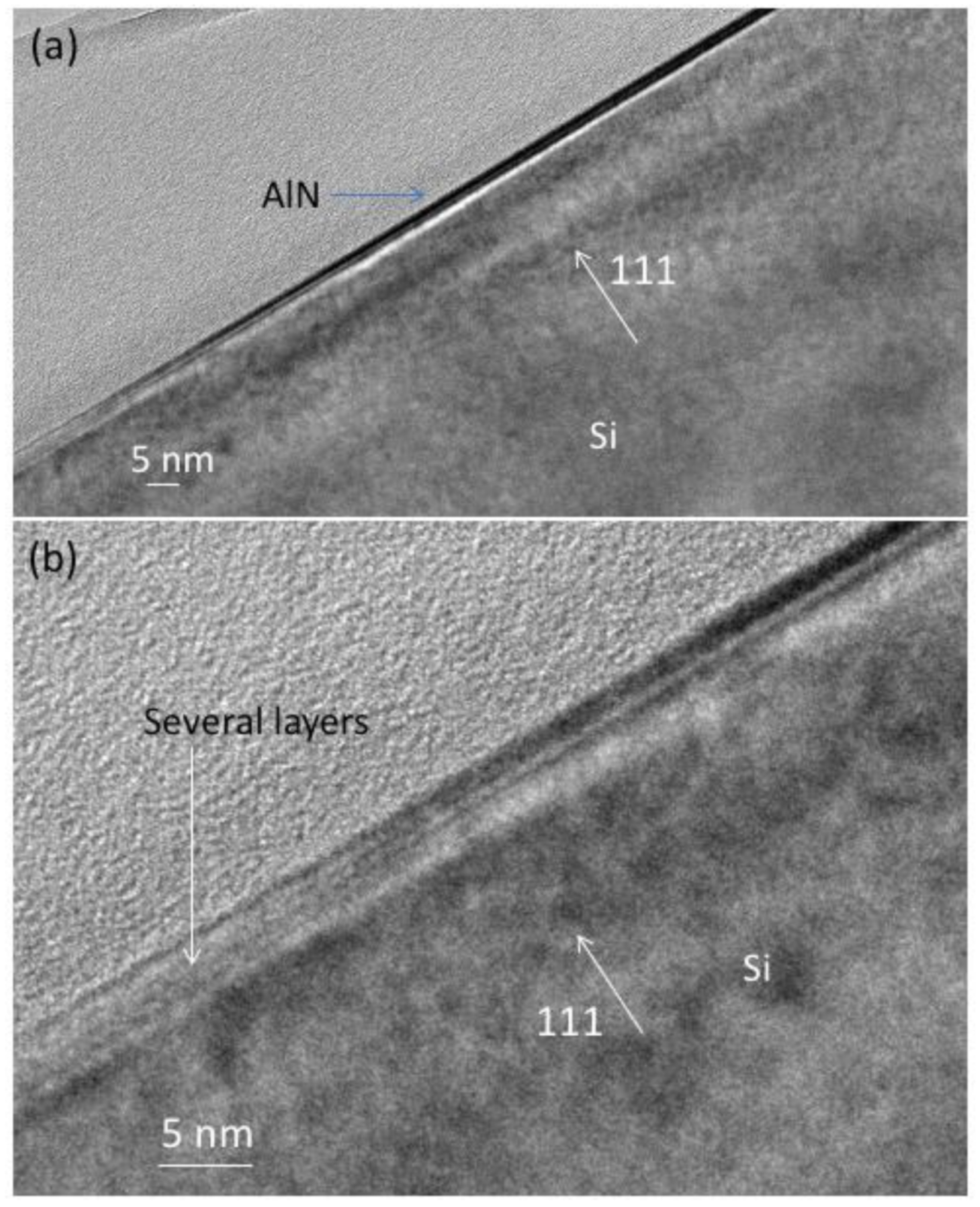
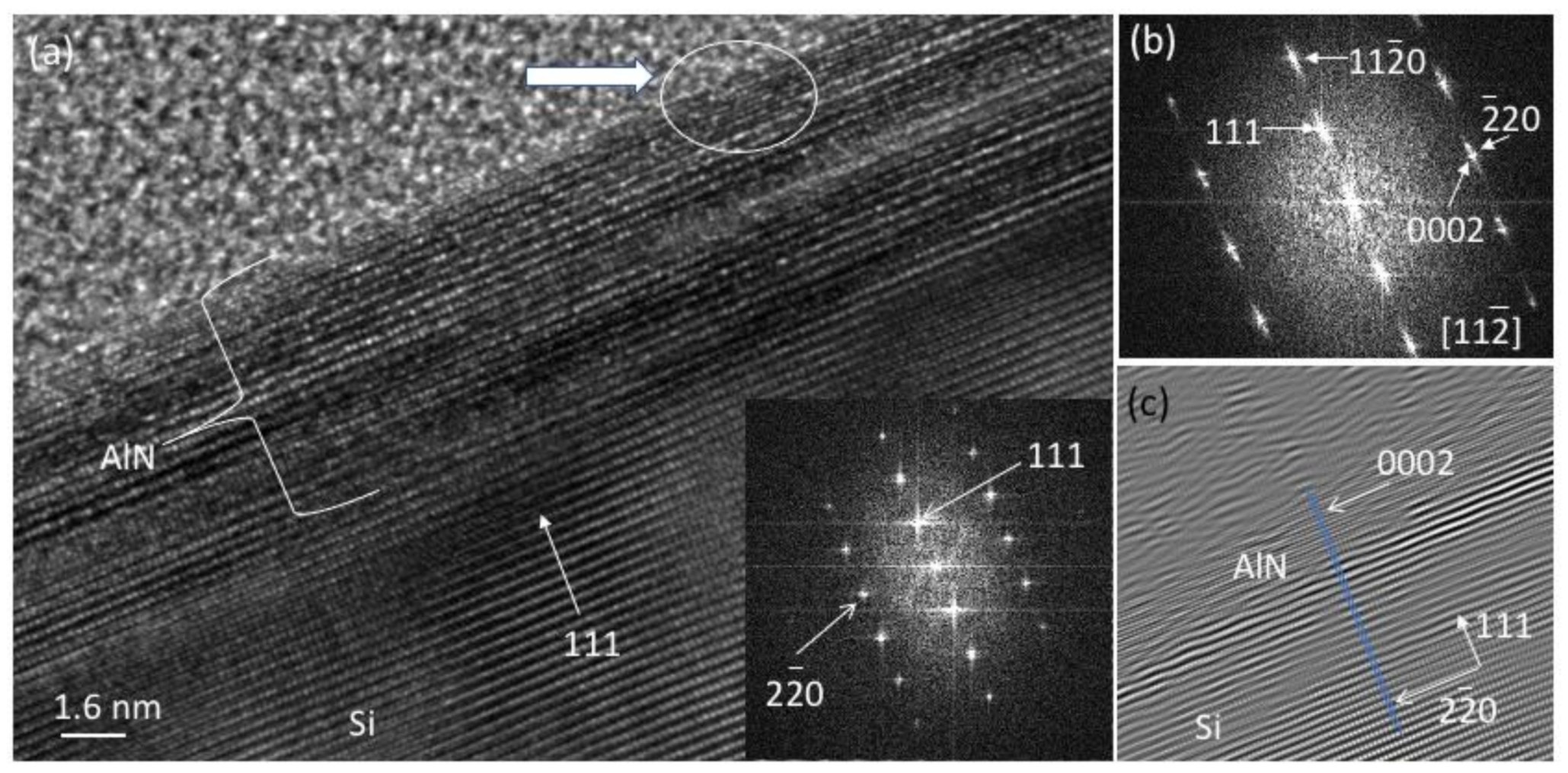
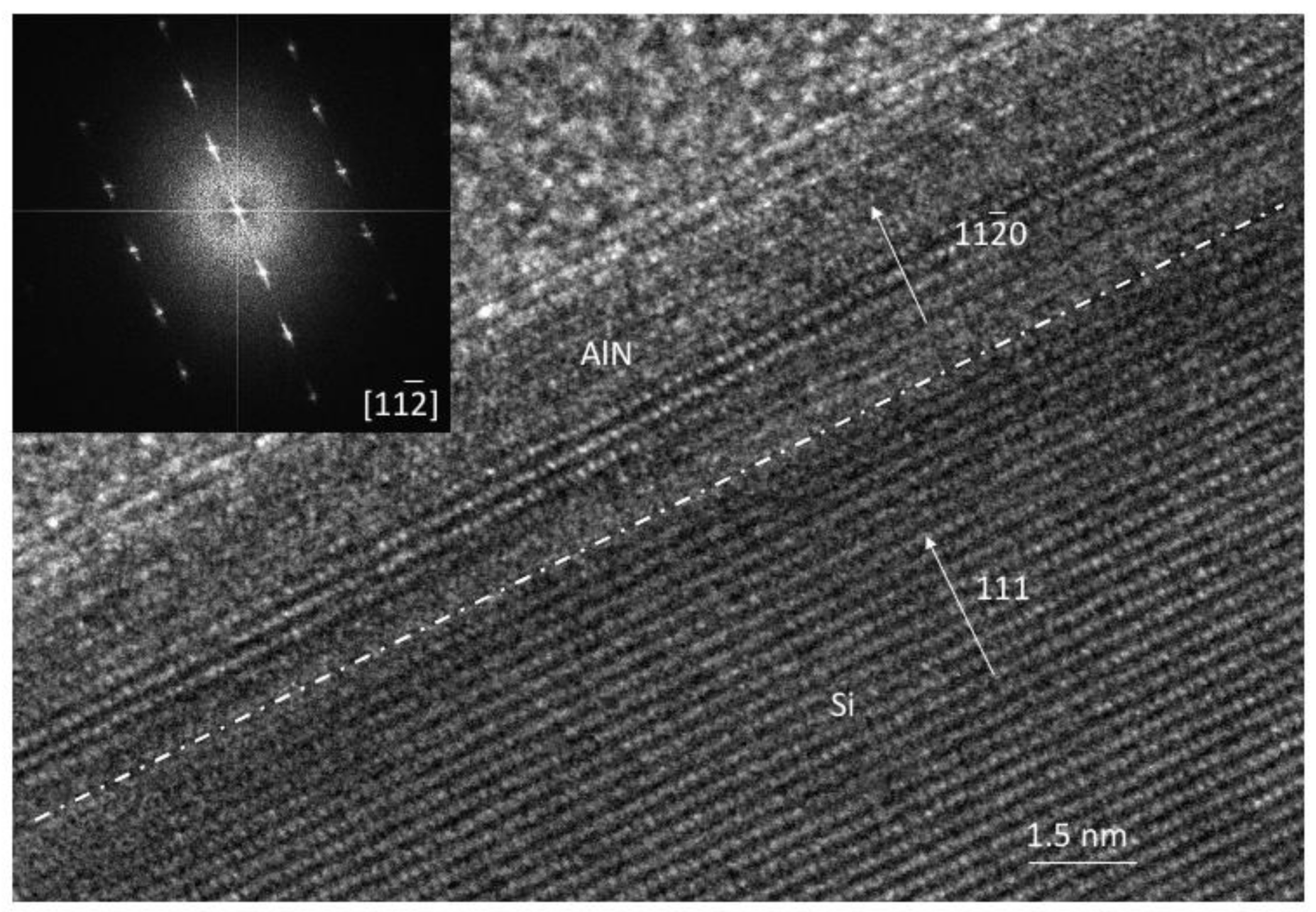
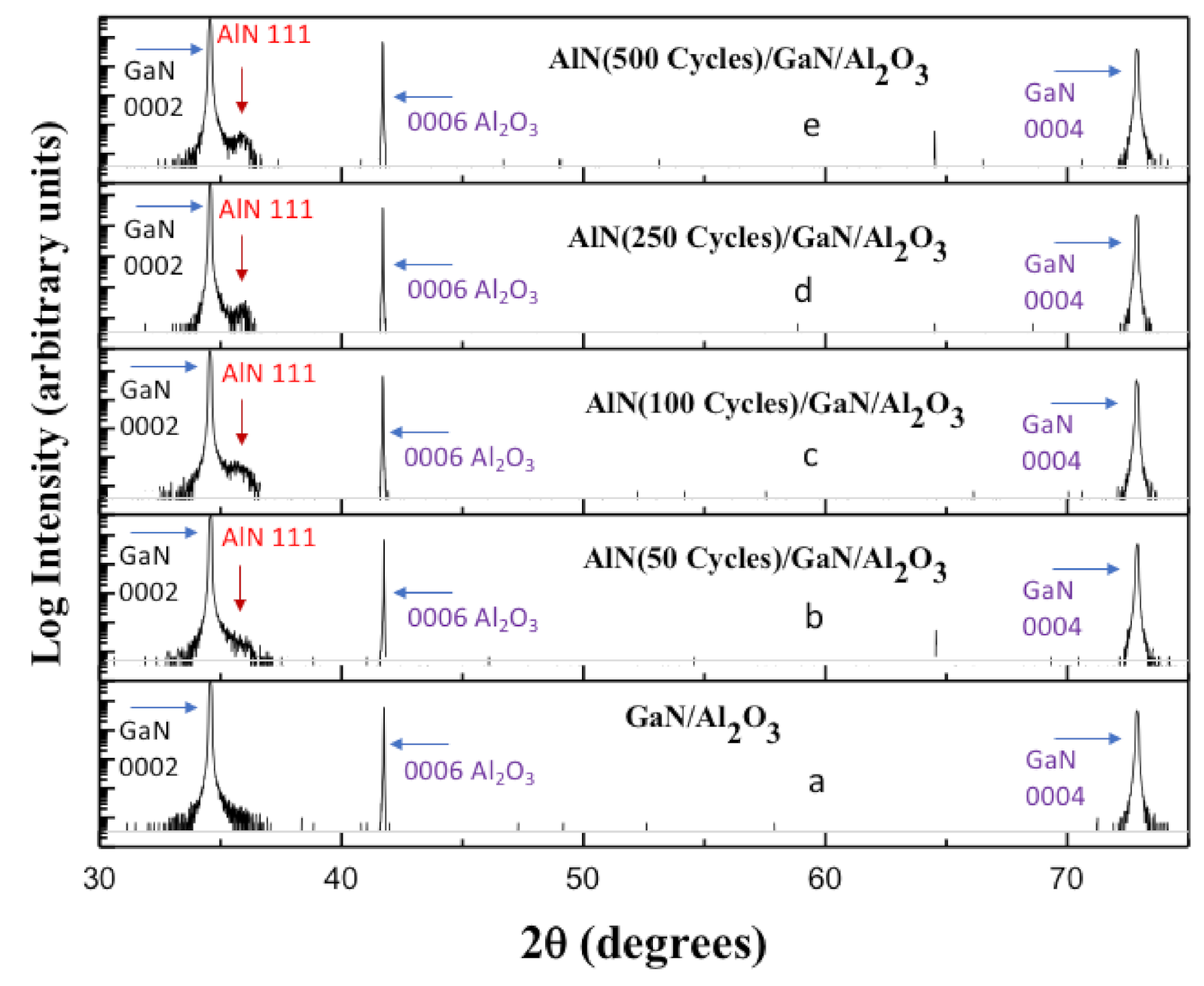
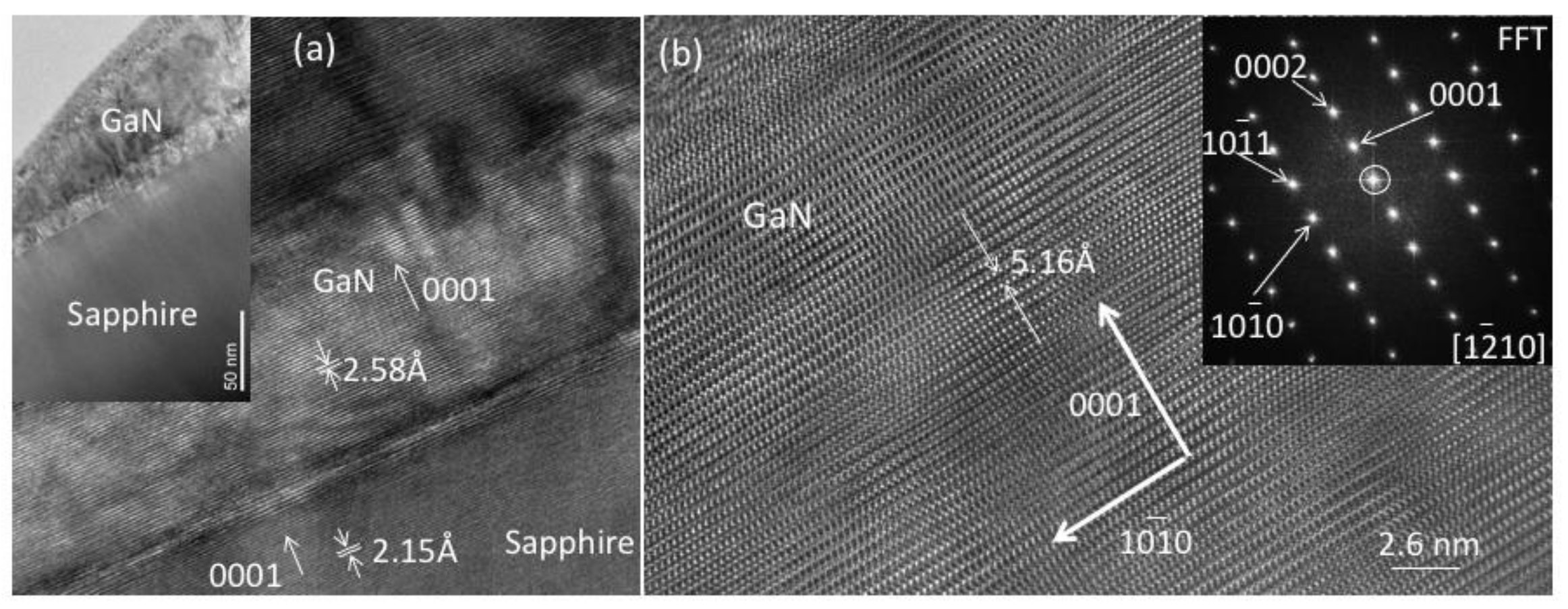
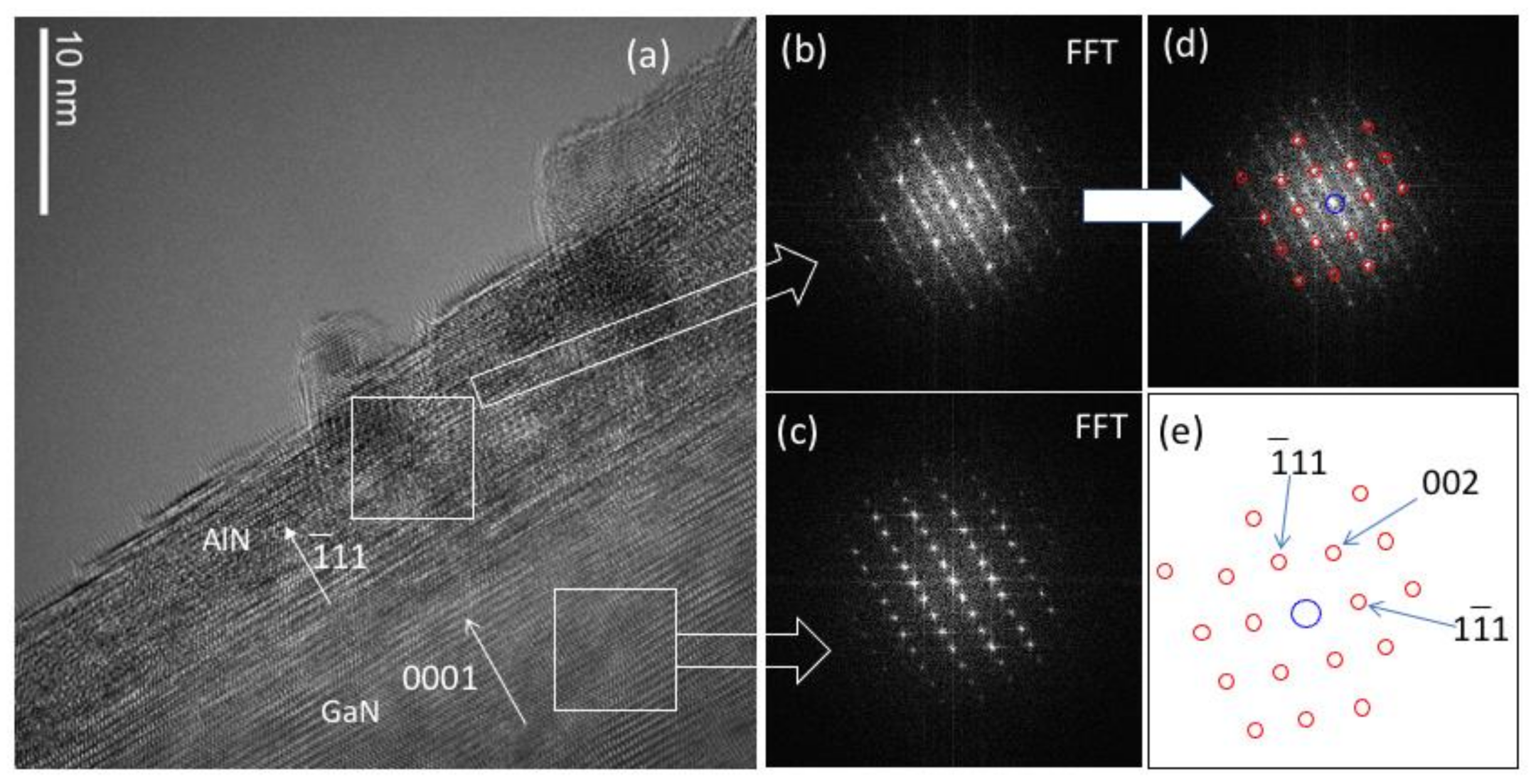
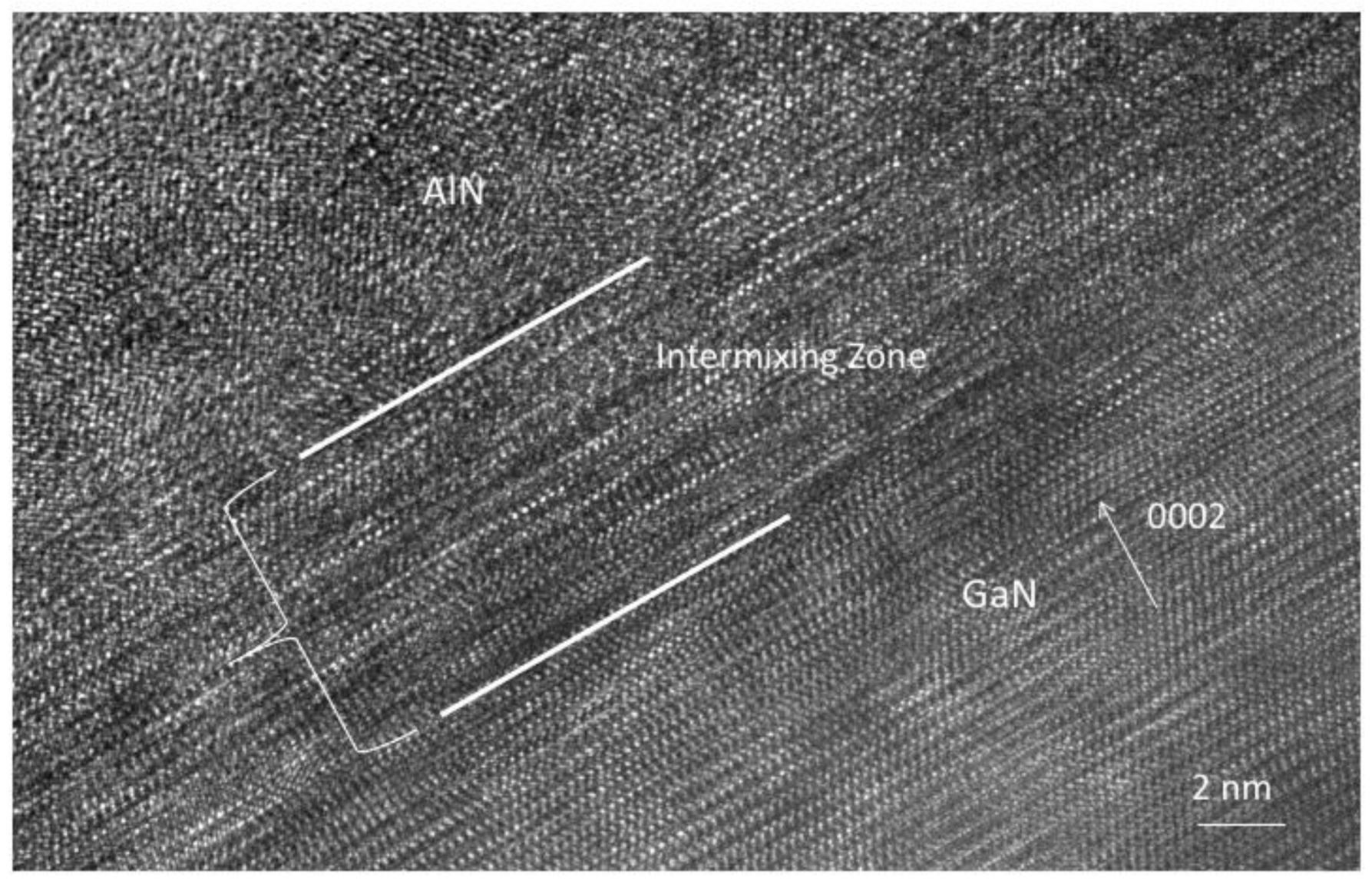
Publisher’s Note: MDPI stays neutral with regard to jurisdictional claims in published maps and institutional affiliations. |
© 2021 by the authors. Licensee MDPI, Basel, Switzerland. This article is an open access article distributed under the terms and conditions of the Creative Commons Attribution (CC BY) license (https://creativecommons.org/licenses/by/4.0/).
Share and Cite
Goswami, R.; Qadri, S.; Nepal, N.; Eddy, C., Jr. Microstructure and Interfaces of Ultra-Thin Epitaxial AlN Films Grown by Plasma-Enhanced Atomic Layer Deposition at Relatively Low Temperatures. Coatings 2021, 11, 482. https://doi.org/10.3390/coatings11040482
Goswami R, Qadri S, Nepal N, Eddy C Jr. Microstructure and Interfaces of Ultra-Thin Epitaxial AlN Films Grown by Plasma-Enhanced Atomic Layer Deposition at Relatively Low Temperatures. Coatings. 2021; 11(4):482. https://doi.org/10.3390/coatings11040482
Chicago/Turabian StyleGoswami, Ramasis, Syed Qadri, Neeraj Nepal, and Charles Eddy, Jr. 2021. "Microstructure and Interfaces of Ultra-Thin Epitaxial AlN Films Grown by Plasma-Enhanced Atomic Layer Deposition at Relatively Low Temperatures" Coatings 11, no. 4: 482. https://doi.org/10.3390/coatings11040482
APA StyleGoswami, R., Qadri, S., Nepal, N., & Eddy, C., Jr. (2021). Microstructure and Interfaces of Ultra-Thin Epitaxial AlN Films Grown by Plasma-Enhanced Atomic Layer Deposition at Relatively Low Temperatures. Coatings, 11(4), 482. https://doi.org/10.3390/coatings11040482





